Mycena galericulata
Mycena galericulata is a mushroom species commonly known as the common bonnet, the toque mycena, or the rosy-gill fairy helmet. The type species of the genus Mycena was first described scientifically in 1772, but was not considered a Mycena until 1821. It is quite variable in color, size, and shape, which makes it somewhat difficult to reliably identify in the field. The mushrooms have caps with distinct radial grooves, particularly at the margin. The cap's color varies from grayish brown to dark brown and the shape ranges from bell-like to bluntly conical to flattened with an umbo. The stem is hollow, white, tough and thin, without a ring and often roots deeply into the wood on which it grows. The gills are white to grayish or even pinkish when mature and are connected by distinct cross-veins. The caps can reach 4 cm (1.6 in) in diameter, and have a mealy odor and taste. The spore print is white and the gills are pink at maturity, which can lead to possible confusion with species of the genus Pluteus. M. galericulata mushrooms grow mostly in clusters on the well-decayed stumps of deciduous and coniferous trees from spring to autumn. The species can generally be considered inedible. It is common and widespread in the entire temperate zone of the Northern Hemisphere, but it has also been reported from Africa.
| Mycena galericulata | |
|---|---|
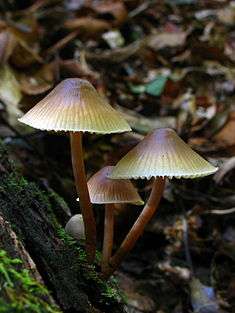 | |
| Scientific classification | |
| Kingdom: | |
| Division: | |
| Class: | |
| Order: | |
| Family: | |
| Genus: | |
| Species: | M. galericulata |
| Binomial name | |
| Mycena galericulata | |
| Synonyms[1] | |
|
Agaricus galericulatus Scop. (1772) | |
| Mycena galericulata | |
|---|---|
float | |
| gills on hymenium | |
| cap is conical | |
| hymenium is adnexed or sinuate | |
| stipe is bare | |
| spore print is white | |
| ecology is saprotrophic | |
| edibility: inedible | |
Taxonomy, classification, and naming
The fungus was first described scientifically as Agaricus galericulatus by Italian mycologist Giovanni Antonio Scopoli in 1772,[2] and sanctioned under this name by Elias Magnus Fries in his 1821 Systema Mycologicum.[3] That same year, Samuel Frederick Gray transferred the species to the genus Mycena.[4] Synonyms for the species include Agaricus conicus named by William Hudson in 1778, Agaricus crispus described by August Johann Georg Karl Batsch in 1893, Stereopodium galericulatum by Franklin Sumner Earle in 1909,[5] and Prunulus galericulatus by William Alphonso Murrill in 1916.[1]
Mycena galericulata is the type species of the genus Mycena. It is classified in section Mycena of Mycena in the infrageneric scheme of Rudolph Arnold Maas Geesteranus.[6] In the older (1947) classification of Alexander H. Smith, he placed it in the subgenus Eumycena, section Typicae—"a most monotonous series of blackish, brown, gray, bluish-gray, or brownish-gray species mostly with ascending gills and generally large to moderate stature."[7]
The specific epithet galericulata is derived from the Latin galer, and means "with a small hat".[8] Gray called it the "helmetted high-stool".[4] It is commonly known as the "common bonnet", the "toque mycena",[8] or the "rosy-gill fairy helmet".[9]
Description
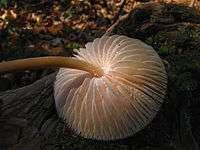
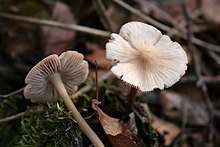
The cap of M. galericulata is roughly conical when young, and eventually becomes broadly bell-shaped or with a broad umbo that can reach diameters of 2–4 cm (0.8–1.6 in). The cap margin is initially somewhat curved inward, but soon evens out or even becomes uplifted, and often splits radially in age. The surface has radial grooves that extend nearly to the center, and feels greasy but not sticky. The color is somewhat buff-brown on the margin, and fades gradually to pale dirty tan to dirty cinnamon-brown. The flesh is thick in the center of the cap and tapers evenly to the margin, and is watery gray, with a cartilage-like texture. The odor and taste are mildly to strongly farinaceous (similar to the smell of freshly ground flour),[10] to radish-like.[11]
The gills are narrowly attached (adnexed) to broadly attached or sinuate. The gill spacing ranges from close to somewhat distantly spaced, with 26–36 gills reaching the stem; there are additionally three or four tiers of lamellulae (short gills that do not extend completely from the cap margin to the stem). The gills are strongly intervenose (possessing cross-veins), moderately broad (5–7 mm), white or grayish white, soon flushed with pale pink, with even edges. The stem is 5–9 cm (2.0–3.5 in) long, 2–4 mm (0.08–0.16 in) thick, equal in width throughout, and with a cartilaginous texture. It is hollow, not hairy, either smooth or twisted with longitudinal striations, often with a long pseudorrhiza (a subterranean elongation of the stem) at the base. The stem color is pale grayish white on the upper portion, and pale grayish black below; the base becomes somewhat dirty brown in age, but does not develop reddish stains.[10]
Mycena galericulata produces a white spore print. The spores are ellipsoid, 8–10 by 5.5–7 μm, and amyloid—which means they will turn blue-black to black when stained with Melzer's reagent. The basidia (spore-bearing cells) have stout sterigmata, and measure 34–40 by 7–9 μm. They may be either two-spored or four-spored. There are numerous club-shaped to rounded cheilocystidia (cystidia on the gill edge), that measure 32–40 by 8–12 μm; their apices or the entire enlarged portion bear rodlike projections that become increasingly elongated and branched in age. There are no pleurocystidia (cystidia on the gill face). The gill tissue has a very thin cuticle, under which is a narrow hypoderm, while the remainder of the tissue comprises densely matted tufts of mycelia, and stains deep vinaceous-brown in iodine.[10] Clamp connections are present in the hyphae of the four-spored forms.[12]
Edibility
Opinions on the edibility of the mushroom vary. One source considers them to have a "delicate flavor and texture", and suggests that they are good when "stewed gently in their own juice and then seasoned with salt, pepper and butter."[13] Others list the species as inedible,[14][8] and notes that they have a "mildly rancid" smell, and with a taste ranging from rancid to farinaceous.[14] Another says "unknown, but not recommended."[9] At any rate, the species falls into the general category of brownish Mycenas that are generally unappetizing as food due to their small size and delicate consistency.[9]
Similar species
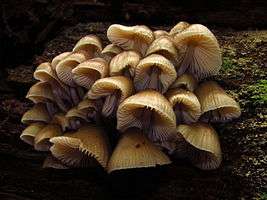
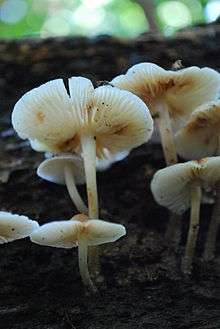
The winter bonnet (M. tintinnabulum) is a northern European species that is much smaller (cap diameter up to 2.6 cm (1.0 in) across) and has a brown cap, and has ragged hairs at the base. It generally appears in late autumn to early winter on the stumps of deciduous trees, especially beech. It has pip-shaped spores that are smaller than M. galericulata, around 4.5–5.5 by 2.5–2.8 µm.[15] M. maculata develops pink stains on its gills as it matures; its spores are 7–9 by 4–5 μm.[16] Another similar species is M. inclinata, which can be distinguished by gills bearing reddish spots, which may become entirely red with age.[14] It also has whitish, slender, threadlike flecks on the stalk. M. parabolica is thinner, and more fragile.[9] Another Mycena that grows in clusters on decaying hardwoods is M. haematopus, but this species has a vinaceous-brown cap with a scalloped margin, and a stem that bleeds reddish-brown juice when injured.[17] M. excisa closely resembles M. galericulata, but can be distinguished microscopically by the presence of both smooth and roughened cystidia (bearing finger-like projections).[18]
Ecology, habitat and distribution
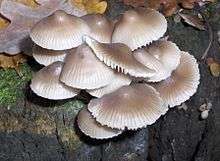
Mycena galericulata is saprobic, and grows on decaying hardwood and softwood sticks, chips, logs, and stumps. It can also grow from submerged wood, which may give it a terrestrial appearance. It typically grows in small clusters or sometimes singly.[19] The fungus fruits from late spring to early winter.[13] A study of litter-decomposing fungi in a coniferous forest in Finland showed that M. galericulata produces extracellular hydrolytic enzymes in the humus and eluvial soil, including β-glucosidase, β-xylosidase, α-glucosidase, butyrate esterase and sulphatase. The enzymes form complexes with inorganic and organic particles in the soil and break down (depolymerize) biopolymers such as cellulose, hemicellulose, and starch, which contributes to the cycling of carbon and nutrients.[20] The presence of lead contamination in the soil decreases both the growth and the extracellular hydrolytic enzyme activity of M. galericulata.[21]
Mycena galericulata is a very common and widely distributed species, found throughout the entire temperate zone of the Northern Hemisphere.[8] In the United States, it occurs throughout eastern North America and also along the Pacific Coast.[10] It has also been collected in Edo State, Nigeria.[22] Although the mushroom has occasionally been reported from Australia, these collections are probably based on misidentifications, and "Australian records of Mycena galericulata are best regarded as erroneous".[23]
References
- "Mycena galericulata (Scop.) Gray 1821". MycoBank. International Mycological Association. Retrieved 2010-09-20.
- Scopoli JA. (1772). Flora carniolica (in Latin). 2 (2 ed.). p. 455.
- Fries EM. (1821). Systema Mycologicum (in Latin). 1. Lundin, Sweden: Ex Officina Berlingiana. p. 143.
- Gray SF. (1821). A Natural Arrangement of British Plants. 1. London, UK: Baldwin, Cradock, and Joy. p. 619.
- Earle FS. (1906). "The genera of North American gill fungi". Bulletin of the New York Botanical Garden. 5: 373–451.
- Maas Geesteranus RA. (1992). Mycenas of the Northern Hemisphere. II. Conspectus of the Mycenas of the Northern Hemisphere. Amsterdam, Netherlands: Koninklijke Nederlandse Akademie van Vetenschappen. ISBN 0-444-85760-5.
- Smith (1947), p. 225.
- Schalkwijk-Barendsen HME. (1991). Mushrooms of Western Canada. Edmonton, Alberta: Lone Pine Publishing. p. 276. ISBN 0-919433-47-2.
- McKnight VB, McKnight KH (1987). A Field Guide to Mushrooms: North America. Boston, Massachusetts: Houghton Mifflin. p. 172. ISBN 0-395-91090-0.
- Smith (1947), pp. 347–51.
- Arora D. (1986). Mushrooms Demystified: a Comprehensive Guide to the Fleshy Fungi. Berkeley, California: Ten Speed Press. pp. 235–6. ISBN 0-89815-169-4.
- Aronsen A. "Mycena galericulata (Scop.) Gray". A key to the Mycenas of Norway. Archived from the original on 2011-06-05. Retrieved 2011-06-15.
- Dickinson C, Lucas J (1982). VNR Color Dictionary of Mushrooms. New York, New York: Van Nostrand Reinhold. pp. 119–20. ISBN 978-0-442-21998-7.
- Miller HR, Miller OK (2006). North American Mushrooms: a Field Guide to Edible and Inedible Fungi. Guilford, Connecticut: Falcon Guide. p. 171. ISBN 0-7627-3109-5.
- Aronsen A. "Mycena tintinnabulum (Fr.) Quél". A key to the Mycenas of Norway. Archived from the original on 2012-10-12. Retrieved 2011-06-15.
- Smith (1947), pp. 341–3.
- Wood M, Stevens F. "Mycena galericulata". California Fungi. MykoWeb. Retrieved 2011-06-14.
- Smith (1947), pp. 303–305.
- Kuo M. (December 2010). "Mycena galericulata". MushroomExpert.Com. Retrieved 2011-02-16.
- Kähkönen MA, Hakulinen R (2011). "Hydrolytic enzyme activities, carbon dioxide production and the growth of litter degrading fungi in different soil layers in a coniferous forest in Northern Finland". European Journal of Soil Biology. 47 (2): 108–13. doi:10.1016/j.ejsobi.2010.12.004.
- Kähkönen MA, Lankinen P, Hatakka A (2008). "Hydrolytic and ligninolytic enzyme activities in the Pb contaminated soil inoculated with litter-decomposing fungi". Chemosphere. 72 (5): 708–14. doi:10.1016/j.chemosphere.2008.04.008. PMID 18499227.
- Idu M, Osemwegie OO, Onyibe HI (2008). "Checklist of flora in Edo State, Nigeria". Plant Archives. 8 (2): 539–49. ISSN 0972-5210.
- Grgurinovic CA. (2003). The Genus Mycena in South-eastern Australia. Fungal Diversity Progress Series No. 9. Hong Kong: Australian Biological Resources Study, Fungal Diversity Press. ISBN 978-962-86765-2-1.
Cited literature
- Smith AH. (1947). North American species of Mycena. Ann Arbor, Michigan: University of Michigan Press.
External links
| Wikimedia Commons has media related to Mycena galericulata. |